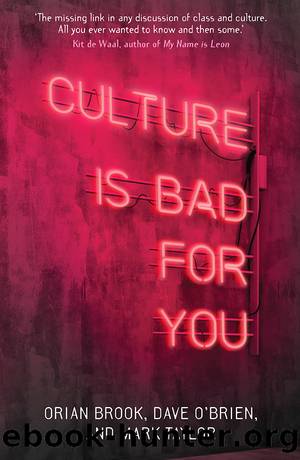Culture Is Bad for You: Inequality in the Cultural and Creative Industries by Orian Brook & Mark Taylor & Dave O'Brien

Author:Orian Brook & Mark Taylor & Dave O'Brien [Brook, Orian & Taylor, Mark & O'Brien, Dave]
Language: eng
Format: epub
ISBN: 9781526144164
Google: -mrJxwEACAAJ
Publisher: Manchester University Press
Published: 2020-11-15T23:46:54.376914+00:00
The somatic norm and inequality in creative occupations
We have introduced the idea of the somatic norm to do two things. First, to expand some of the criticisms of social mobility to connect more closely with the issues of getting in and getting on in creative occupations. Second, to provide a way of organising our data, as weâre going to be thinking about how the somatic norm relates to embodied forms of cultural capital.
First, we will take some time to think about how the somatic norm works in creative occupations, and how it structures particular individualsâ chances of success. A simple and straightforward example comes from the world of acting.20 Getting work in acting is tough. It is highly competitive and decisions are often based on intangible qualities, rather than formal credentials. It is also highly precarious, with very uncertain patterns of employment, even for the relatively successful. Finally, it has a range of structural inequalities, with many more parts in mainstream productions available to men, particularly men with specific characteristics.
Here we can see the somatic norm in operation. The roles individuals are encouraged to audition for, and get, follow a set social âtypeâ. The type reflects demographic characteristics of age, gender, ethnicity, region, disability, sexuality, and class. In some ways this is benign, as there are parts available for a range of actors depending on their type.
Yet the fit between actor and part operates in a highly unequal way. A White, male actor, with a received pronunciation accent, is assumed to be the default. He is capable of playing any role. This is the somatic norm for actors. Those without these characteristics face a more limited set of opportunities. They are assumed to only be able to play their type. This type is determined by casting directors, writers, and producers.
This somatic norm is then coupled with broader structures of inequality in the profession. There are fewer parts for women, and for people of colour. Moreover, the parts offered to those not fitting the somatic norm can present a dilemma. Often parts are crude caricatures of the lives of the working class, of women, or of people of colour. These parts are commissioned by those with sometimes little or no experience of what is being represented on stage or screen.
There is a burden of representation that is not demanded of the men that are the somatic norm. For the White, middle-class origin man there are frustrations, for sure. They may be confined to play leading men, key parts in Shakespeare, or only rarely offered the chance to do challenging or ground-breaking roles.
For women, working-class origin individuals, and people of colour the frustrations are different. They will be offered unrepresentative and offensive roles: one-dimensional love interests, benefits cheats, drug dealers, or terrorists. They are not afforded the same, highly privileged, constraints associated with the somatic norm. In turn, these negative representations have real-world consequences for how particular communities are viewed.
The operation of the somatic norm in acting reflects the dominance of the middle class in hiring and commissioning decisions.
Download
This site does not store any files on its server. We only index and link to content provided by other sites. Please contact the content providers to delete copyright contents if any and email us, we'll remove relevant links or contents immediately.
| Coloring Books for Grown-Ups | Humor |
| Movies | Performing Arts |
| Pop Culture | Puzzles & Games |
| Radio | Sheet Music & Scores |
| Television | Trivia & Fun Facts |
Paper Towns by Green John(5061)
Spare by Prince Harry The Duke of Sussex(5052)
Machine Learning at Scale with H2O by Gregory Keys | David Whiting(4101)
Never by Ken Follett(3760)
Learning C# by Developing Games with Unity 2021 by Harrison Ferrone(3322)
Fairy Tale by Stephen King(3192)
The Man Who Died Twice by Richard Osman(2977)
Fantastic Beasts and Where to Find Them: Illustrated edition by J.K. Rowling & Newt Scamander(2958)
Reminders of Him: A Novel by Colleen Hoover(2928)
0041152001443424520 .pdf by Unknown(2769)
Will by Will Smith(2767)
How The Mind Works by Steven Pinker(2713)
Fantastic Beasts and Where to Find Them: The Original Screenplay by J. K. Rowling(2458)
Never Lie: An addictive psychological thriller by Freida McFadden(2331)
Rationality by Steven Pinker(2271)
The God delusion by Richard Dawkins(2251)
Borders by unknow(2212)
It Starts With Us (It Ends with Us #2) by Colleen Hoover(2171)
The Dawn of Everything: A New History of Humanity by David Graeber & David Wengrow(2103)
